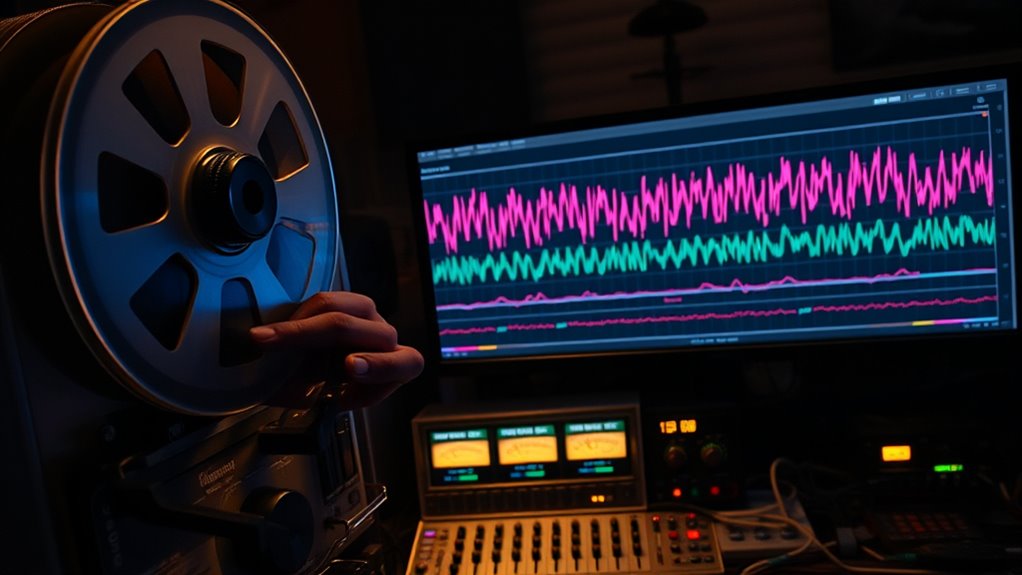To transcribe noisy recordings effectively, you can apply signal processing tricks like noise suppression techniques that reduce background sounds and enhance speech clarity. Use algorithms such as spectral subtraction or adaptive filtering to minimize unwanted noise while preserving the speech signal. Extract features like Mel-Frequency Cepstral Coefficients (MFCCs) to focus on important speech characteristics. Exploring these methods further will reveal how combining noise reduction with feature extraction boosts transcription accuracy even in tough audio conditions.
Key Takeaways
- Apply noise suppression techniques like spectral subtraction and adaptive filtering before feature extraction to enhance speech clarity.
- Use feature extraction methods such as MFCCs to capture robust speech features resilient to residual noise.
- Fine-tune noise reduction algorithms based on the specific noise profile for optimal results.
- Combine multiple signal processing tricks, including filtering and feature enhancement, to improve transcription accuracy.
- Prioritize processing steps to maximize speech signal quality, reducing errors in subsequent transcription stages.

Have you ever tried to transcribe a recording filled with background noise or poor audio quality? If so, you know how frustrating it can be to decipher speech when the audio isn’t clear. Fortunately, signal processing techniques can help you improve the transcription process. One of the key strategies is noise suppression, which aims to reduce unwanted sounds that obscure the main speech signals. Noise suppression algorithms analyze the audio to identify background sounds like traffic, chatter, or static, then minimize their presence without distorting the speech itself. This process makes the voice stand out more prominently, increasing the accuracy of subsequent transcription efforts.
Alongside noise suppression, feature extraction plays a crucial role. Feature extraction involves breaking down the audio into measurable components that capture essential speech characteristics. These features might include spectral properties, pitch, or formant frequencies. When you extract features effectively, you create a more resilient representation of the speech signal that can be analyzed even amid residual noise. This process helps machine learning models or speech recognition algorithms focus on the relevant parts of the audio, ignoring the extraneous sounds. By combining noise suppression with feature extraction, you lay a solid foundation for clearer, more intelligible transcriptions.
Effective feature extraction creates a resilient speech representation, improving transcription accuracy amid residual noise.
Implementing noise suppression isn’t just about applying a filter; it requires understanding the nature of the noise and choosing the right technique. For example, spectral subtraction algorithms estimate the noise profile during silent segments and subtract it from the noisy audio. Adaptive filtering dynamically adjusts to changing noise environments, providing continuous enhancement. Once the noise is reduced, feature extraction algorithms like Mel-Frequency Cepstral Coefficients (MFCCs) can be used to capture the core speech features. These features are less affected by residual noise, making them ideal for feeding into transcription models.
It’s important to note that effective noise suppression and feature extraction aren’t magic tricks; they demand fine-tuning. You may need to experiment with different algorithms or parameters to get the best results. Additionally, sometimes combining multiple techniques yields the best outcome. For example, applying noise suppression first, then performing feature extraction, helps ensure the speech signal is as clean as possible before transcription. With these signal processing tricks, you’ll find it easier to transcribe recordings that once seemed too noisy or poor in quality, saving you time and increasing accuracy.
A good understanding of signal processing techniques can significantly improve the quality of your transcriptions and overall audio analysis.
Frequently Asked Questions
How Do Different Noise Types Affect Transcription Accuracy?
Different noise types can considerably impact your transcription accuracy. For steady background noise, spectral subtraction helps by reducing consistent signals, while noise gating cuts off sounds below a certain threshold, minimizing sudden noise bursts. However, unpredictable noises like speech overlaps or environmental sounds may still cause errors. Using these techniques together can improve clarity, but understanding the noise type guides you in choosing the most effective method for more accurate transcriptions.
Can Real-Time Noise Reduction Improve Transcription Speed?
Real-time noise reduction can definitely boost your transcription speed by improving audio preprocessing. When you use real-time filtering, you remove background noise instantly, making speech clearer for your transcription software. This reduces the need for multiple correction passes and speeds up the process. With cleaner audio, your system can transcribe more efficiently, saving you time and effort while ensuring higher accuracy in noisy environments.
What Hardware Tools Enhance Signal Clarity for Noisy Recordings?
Think of your hardware setup as a shield protecting your recordings from noise. Choosing the right microphone, like a finely tuned instrument, captures clearer sound. Acoustic treatment, like a cozy blanket for your room, reduces echoes and background noise. These tools work together to enhance signal clarity, making your recordings much cleaner. With proper hardware choices, you’ll get crisper audio, which ultimately makes transcription more accurate and efficient.
How Does Background Noise Impact AI Transcription Models?
Background noise can substantially impact AI transcription models by making it harder to accurately interpret speech. You can improve results through audio augmentation, which adds variability to training data, and noise profiling, which helps the model distinguish speech from background sounds. These techniques enable the AI to become more robust, effectively filtering out noise and enhancing transcription accuracy despite challenging audio environments.
Are There Specific Algorithms Best Suited for Various Noise Environments?
You’ll find that different algorithms work best for various noise environments. Spectral subtraction is effective for stationary noises, like fans or constant hums, by removing consistent background sounds. Adaptive filtering excels in dynamic environments, adjusting in real-time to changing noise patterns such as crowds or traffic. By selecting the right technique—spectral subtraction or adaptive filtering—you improve transcription accuracy and reduce background interference, making your AI models more reliable across diverse noise conditions.
Conclusion
So, next time you’re stuck with a noisy recording, remember: it’s not your fault, it’s just advanced signal processing tricks working their magic. Who knew that a little filtering and some clever algorithms could turn a mess into a masterpiece? Just sit back, pretend you’re a tech wizard, and enjoy the illusion of clarity. After all, in the world of noisy recordings, you’re just one smart trick away from sounding like a pro—no magic required.











